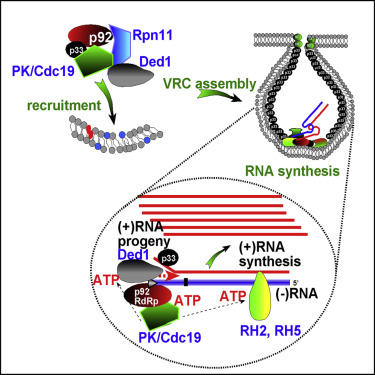Cell Host & Microbe ( IF 30.3 ) Pub Date : 2017-11-05 , DOI: 10.1016/j.chom.2017.10.004 Chingkai Chuang , K. Reddisiva Prasanth , Peter D. Nagy

|
Viruses accomplish their replication by exploiting many cellular resources, including metabolites and energy. Similarly to other (+)RNA viruses, tomato bushy stunt virus (TBSV) induces major changes in infected cells. However, the source of energy required to fuel TBSV replication is unknown. We find that TBSV co-opts the cellular glycolytic ATP-generating pyruvate kinase (PK) directly into the viral replicase complex to boost progeny RNA synthesis. The co-opted PK generates high levels of ATP within the viral replication compartment at the expense of a reduction in cytosolic ATP pools. The ATP generated by the co-opted PK is used to promote the helicase activity of recruited cellular DEAD-box helicases, which are involved in the production of excess viral (+)RNA progeny. Altogether, recruitment of PK and local production of ATP within the replication compartment allow the virus replication machinery an access to plentiful ATP, facilitating robust virus replication.
中文翻译:

糖酵解丙酮酸激酶直接募集到病毒复制酶复合物中,以产生用于RNA合成的ATP。
病毒通过利用许多细胞资源(包括代谢物和能量)来完成其复制。与其他(+)RNA病毒相似,番茄丛状特技病毒(TBSV)诱导感染细胞发生重大变化。但是,为TBSV复制提供动力所需的能源尚不清楚。我们发现,TBSV将细胞糖酵解ATP产生的丙酮酸激酶(PK)直接加入病毒复制酶复合物中,以增强子代RNA的合成。共同选择的PK在病毒复制区室中产生高水平的ATP,但以减少胞质ATP池为代价。由共选PK产生的ATP用于促进募集的细胞DEAD-box解旋酶的解旋酶活性,这些酶参与了过量病毒(+)RNA后代的产生。共,



























 京公网安备 11010802027423号
京公网安备 11010802027423号